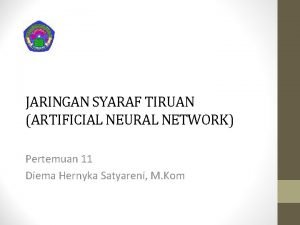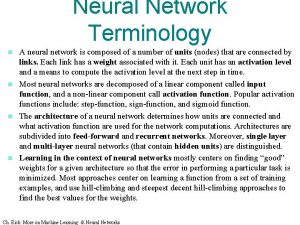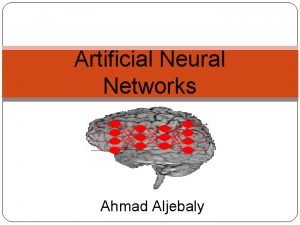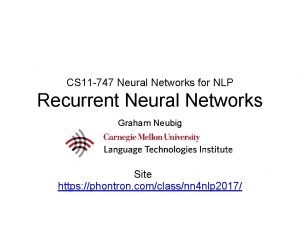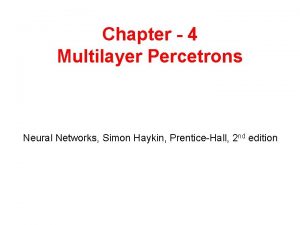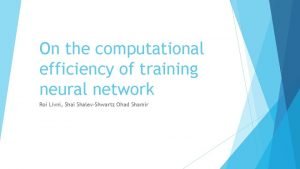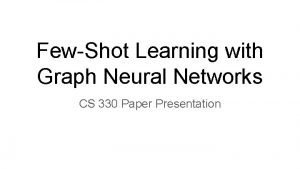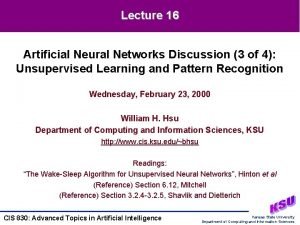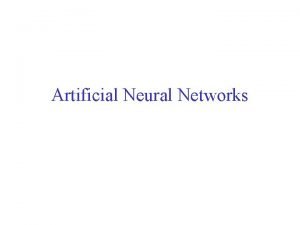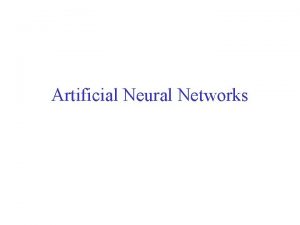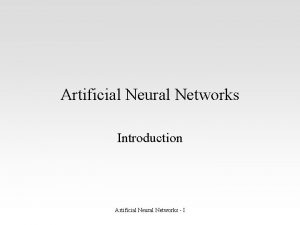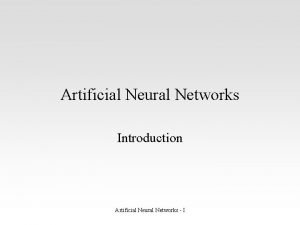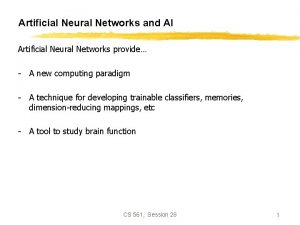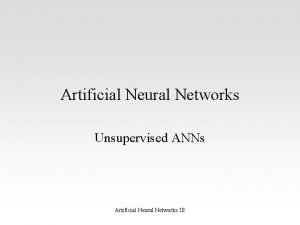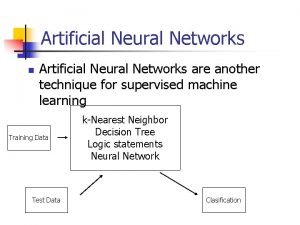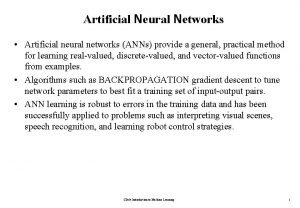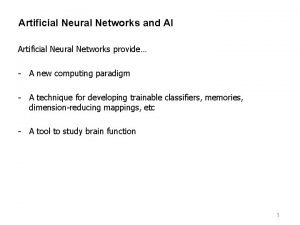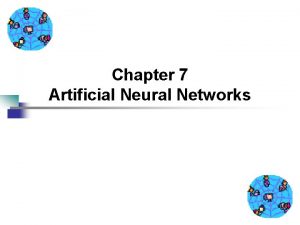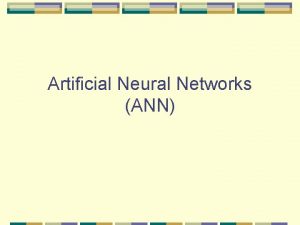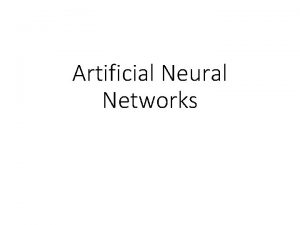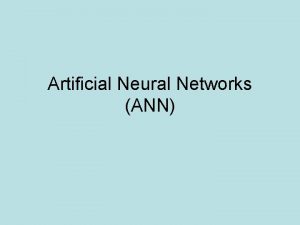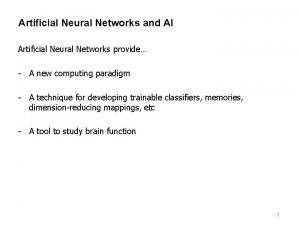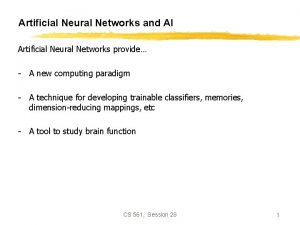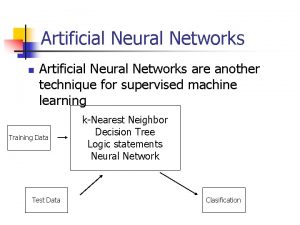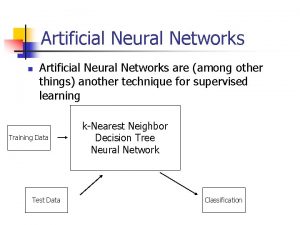Introduction to Neural Networks 2 ARTIFICIAL INTELLIGENCE TECHNIQUES















































- Slides: 47

Introduction to Neural Networks 2 ARTIFICIAL INTELLIGENCE TECHNIQUES

Overview The Mc. Culloch-Pitts neuron Pattern space Limitations Learning

Mc. Culloch-Pitts model X 1 X 2 X 3 W 1 W 2 T W 3 Y=1 if W 1 X 1+W 2 X 2+W 3 X 3 T Y=0 if W 1 X 1+W 2 X 2+W 3 X 3<T Y

Introduce the bias Take threshold over to the other side of the equation and replace it with a weight W 0 which equals -T, and include a constant input X 0 which equals 1. Y=1 if W 1 X 1+W 2 X 2+W 3 X 3 - T 0 Y=0 if W 1 X 1+W 2 X 2+W 3 X 3 -T <0 Y=1 if W 1 X 1+W 2 X 2+W 3 X 3 +W 0 X 0 0 Y=0 if W 1 X 1+W 2 X 2+W 3 X 3 +W 0 X 0 <0

Logic functions X 0 - OR -1 X 1 Y 1 X 2 1 Y = X 1 OR X 2

Logic functions - AND X 0 -2 X 1 Y 1 X 2 1 Y = X 1 AND X 2

Logic functions - NOT X 0 0 Y X 1 -1 Y = NOT X 1

The weighted sum The weighted sum, Σ Wi. Xi is called the “net” sum. Net = Σ Wi. Xi y=1 if net 0 y=0 if net < 0

Hard-limiter The threshold function is known as a hard-limiter. y 1 0 net When net is zero or positive, the output is 1, when net is negative the output is 0.

Example Original image 0 +1 Net = 14 Weights -1 +1

Example with bias With a bias of -14, the weighted sum, net, is 0. Any pattern other than the original will produce a sum that is less than 0. If the bias is changed to -13, then patterns with 1 bit different from the original will give a sum that is 0 or more, so an output of 1.

Generalisation The neuron can respond to the original image and to small variations The neuron is said to have generalised because it recognises patterns that it hasn’t seen before

Pattern space To understand what a neuron is doing, the concept of pattern space has to be introduced A pattern space is a way of visualizing the problem It uses the input values as co-ordinates in a space

Pattern space in 2 dimensions X 1 X 2 Y 0 0 1 1 1 X 2 1 The AND function 1 0 0 0 1 X 1

Linear separability The AND function shown earlier had weights of -2, 1 and 1. Substituting into the equation for net gives: net = W 0 X 0+W 1 X 1+W 2 X 2 = -2 X 0+X 1+X 2 Also, since the bias, X 0, always equals 1, the equation becomes: net = -2+X 1+X 2

Linear separability The change in the output from 0 to 1 occurs when: net = -2+X 1+X 2 = 0 This is the equation for a straight line. X 2 = -X 1 + 2 Which has a slope of -1 and intercepts the X 2 axis at 2. This line is known as a decision surface.

Linear separability X 1 X 2 Y 0 0 1 1 1 X 2 2 1 The AND function 0 0 1 2 X 1

Linear separability When a neuron learns it is positioning a line so that all points on or above the line give an output of 1 and all points below the line give an output of 0 When there are more than 2 inputs, the pattern space is multi-dimensional, and is divided by a multi-dimensional surface (or hyperplane) rather than a line

Demonstration on linearly/non-linearly separatability Image analysis Generality demonstration

Are all problems linearly separable? No For example, the XOR function is non-linearly separable Non-linearly separable functions cannot be implemented on a single neuron

Exclusive-OR (XOR) X 1 X 2 Y 0 0 1 1 1 0 X 2 2 ? ? 1 0 0 1 2 X 1

Learning A single neuron learns by adjusting the weights The process is known as the delta rule Weights are adjusted in order to minimise the error between the actual output of the neuron and the desired output Training is supervised, which means that the desired output is known

Delta rule The equation for the delta rule is: ΔWi = ηXiδ = ηXi(d-y) where d is the desired output and y is the actual output. The Greek “eta”, η, is a constant called the learning coefficient and is usually less than 1. ΔWi means the change to the weight, Wi.

Delta rule The change to a weight is proportional to Xi and to d-y. If the desired output is bigger than the actual output then d - y is positive If the desired output is smaller than the actual output then d - y is negative If the actual output equals the desired output the change is zero

Changes to the weight

Example Assume that the weights are initially random The desired function is the AND function The inputs are shown one pattern at a time and the weights adjusted

The AND function

Example Start with random weights of 0. 5, -1, 1. 5 When shown the input pattern 1 0 0 the weighted sum is: net = 0. 5 x 1 + (-1) x 0 + 1. 5 x 0 = 0. 5 This goes through the hard-limiter to give an output of 1. The desired output is 0. So the changes to the weights are: W 0 W 1 W 2 negative zero

Example New value of weights (with η equal to 0. 1) of 0. 4, -1, 1. 5 When shown the input pattern 1 0 1 the weighted sum is: net = 1 x 0. 4 + (-1) x 0 + 1. 5 x 1 = 1. 9 This goes through the hard-limiter to give an output of 1. The desired output is 0. So the changes to the weights are: W 0 W 1 W 2 negative zero negative

Example New value of weights of 0. 3, -1, 1. 4 When shown the input pattern 1 1 0 the weighted sum is: net = 1 x 0. 3 + (-1) x 1 + 1. 4 x 0 = -0. 7 This goes through the hard-limiter to give an output of 0. The desired output is 0. So the changes to the weights are: W 0 W 1 W 2 zero

Example New value of weights of 0. 3, -1, 1. 4 When shown the input pattern 1 1 1 the weighted sum is: net = 1 x 0. 3 + (-1) x 1 + 1. 4 x 1 = 0. 7 This goes through the hard-limiter to give an output of 1. The desired output is 1. So the changes to the weights are: W 0 W 1 W 2 zero

Example - with η = 0. 5

Example

Example

Example

Example

Example

Example

What happened in pattern space X 2 2 1 -1 2 3 X 1

What happened in pattern space X 2 2 1 -1 2 3 X 1

What happened in pattern space X 2 2 1 -1 2 3 X 1

What happened in pattern space X 2 2 1 -1 2 3 X 1

What happened in pattern space X 2 2 1 -1 2 3 X 1

What happened in pattern space X 2 2 1 -1 2 3 X 1

What happened in pattern space X 2 2 1 -1 2 3 X 1

Conclusions A single neuron can be trained to implement any linearly separable function Training is achieved using the delta rule which adjusts the weights to reduce the error Training stops when there is no error Training is supervised

Conclusions To understand what a neuron is doing, it help to picture what’s going on in pattern space A linearly separable function can divide the pattern space into two areas using a hyperplane If a function is not linearly separable, networks of neurons are needed
 Best for search
Best for search Introduction to neural networks using matlab
Introduction to neural networks using matlab Cnn ppt for image classification
Cnn ppt for image classification Xooutput
Xooutput Introduction to artificial intelligence and expert systems
Introduction to artificial intelligence and expert systems Cpsc 322: introduction to artificial intelligence
Cpsc 322: introduction to artificial intelligence Cpsc 322: introduction to artificial intelligence
Cpsc 322: introduction to artificial intelligence Pengertian artificial neural network
Pengertian artificial neural network Artificial neural network in data mining
Artificial neural network in data mining Neural network terminology
Neural network terminology Artificial neural network conclusion
Artificial neural network conclusion Visualizing and understanding convolutional networks
Visualizing and understanding convolutional networks Vc dimension of neural networks
Vc dimension of neural networks Lateralization
Lateralization Audio super resolution using neural networks
Audio super resolution using neural networks Convolutional neural networks for visual recognition
Convolutional neural networks for visual recognition Style transfer
Style transfer Efficient processing of deep neural networks pdf
Efficient processing of deep neural networks pdf Mippers
Mippers Least mean square algorithm in neural network
Least mean square algorithm in neural network Rnn
Rnn Neural networks for rf and microwave design
Neural networks for rf and microwave design 11-747 neural networks for nlp
11-747 neural networks for nlp Neural networks simon haykin
Neural networks simon haykin Csrmm
Csrmm On the computational efficiency of training neural networks
On the computational efficiency of training neural networks Tlu neural network
Tlu neural network Neural networks and fuzzy logic
Neural networks and fuzzy logic Convolutional neural networks
Convolutional neural networks Few shot learning with graph neural networks
Few shot learning with graph neural networks Deep forest towards an alternative to deep neural networks
Deep forest towards an alternative to deep neural networks Convolutional neural networks
Convolutional neural networks Neuraltools neural networks
Neuraltools neural networks Rnn
Rnn Predicting nba games using neural networks
Predicting nba games using neural networks Neural networks and learning machines
Neural networks and learning machines The wake-sleep algorithm for unsupervised neural networks
The wake-sleep algorithm for unsupervised neural networks Audio super resolution
Audio super resolution Convolutional neural network alternatives
Convolutional neural network alternatives R1/xcon expert system
R1/xcon expert system State space artificial intelligence
State space artificial intelligence Searching for solutions in artificial intelligence
Searching for solutions in artificial intelligence 15-780 graduate artificial intelligence
15-780 graduate artificial intelligence Knowledge manipulation in ai
Knowledge manipulation in ai Types of knowledge in ai
Types of knowledge in ai Vandelay art. seinfeld the show about nothing. penguin 1997
Vandelay art. seinfeld the show about nothing. penguin 1997 Artificial intelligence leadership
Artificial intelligence leadership Artificial intelligence assessment
Artificial intelligence assessment







